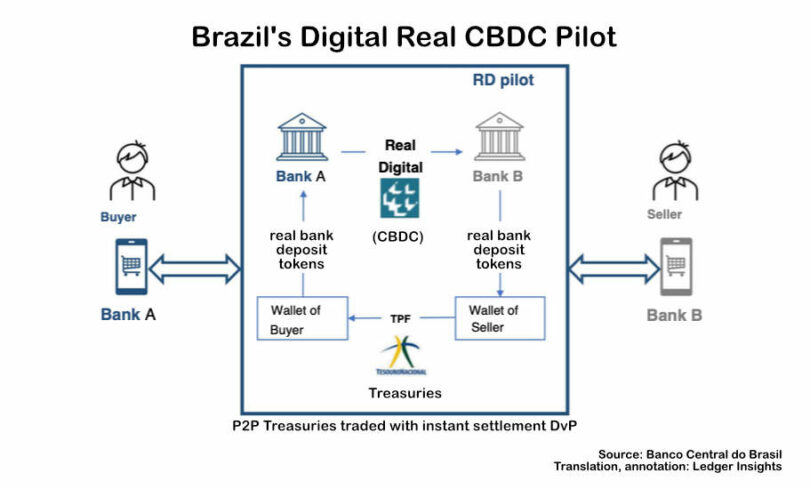Yesterday afternoon, Banco Central do Brasil announced the formal start of its digital real central bank digital currency (CBDC) pilot, with the final rollout expected by the end of 2024. The CBDC is based on a distributed ledger technology (DLT) designed to settle wholesale interbank transactions. However, retail access will be enabled through tokenized bank deposits. The central bank also said the Treasury is contemplating issuing tokenized government bonds.
Pilot transactions will target instant settlements to ensure delivery versus payment (DvP) of financial assets with some programmability. Crucially, this will allow transactions between banks using the CBDC with instant settlement at the end customer level using deposit tokens. The central bank also wants to test the privacy of these transactions. Rather than real transactions, initially the pilot will involve simulations.
One of the main reasons for not targeting mainstream retail payments is the success of Brazil’s “Pix”, an instant payment method that allows individuals and organizations to transfer and receive money, make purchases, and pay bills.
“When we started the discussion about CBDC here at the central bank and looked at the international scenarios, we saw that the problems that the (other) central banks proposed to solve using this technology, we already have very good answers to within our systems,” said Fabio Araujo, coordinator of the digital real initiative, who hinted that the CBDC will function as a sort of “Pix for financial services”. This would allow for the instant transfer of financial assets, reducing costs and increasing returns on investment by removing the need for intermediaries. More broadly, it will lead to the creation of a new range of financial services.
The development and testing phase will run until February 2024, after which the assessment stage will begin. During the pilot stage, participation will be restricted to a limited number of entities and a restricted set of opening hours. A consultation Forum will explore policy issues.
Other organizations involved are the National Treasury Secretariat (STN) for the potential government bond tokens and the Securities and Exchange Commission (CVM) to provide input for future phases involving CVM-regulated securities.
The chosen platform for the pilot is a permissioned version of the Hyperledger Besu blockchain client due to its compatibility with an Ethereum Virtual Machine (EVM).
CBDC guidelines updated
Lastly, the announcement updated the general guidelines for the digital real initiative, including an emphasis on developing innovative models (with a focus on online applications), supporting retail financial services offerings, and adopting resiliency and cybersecurity standards.
The DLT-based solution will allow for the following:
- The registration of different types of assets
- Decentralization in the provision of products and services
- Interoperability with legacy domestic systems
- Integration with systems from other jurisdictions, aiming to enable cross-border payments.
In the runup to the pilot phase, the central bank conducted the LIFT Challenge. Nine different use cases were prototyped, ranging from farmers who received restricted use digital currency, to payments for crypto-assets on a public blockchain.
Update: Added the guidelines section and more on Pix






